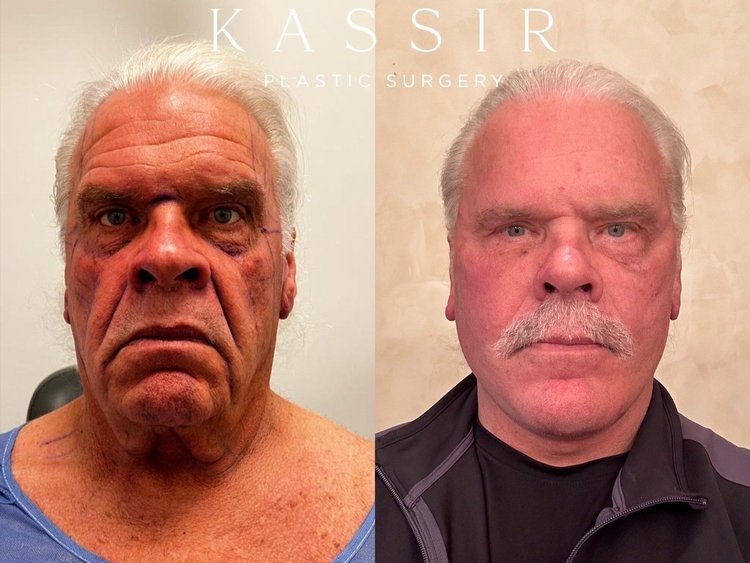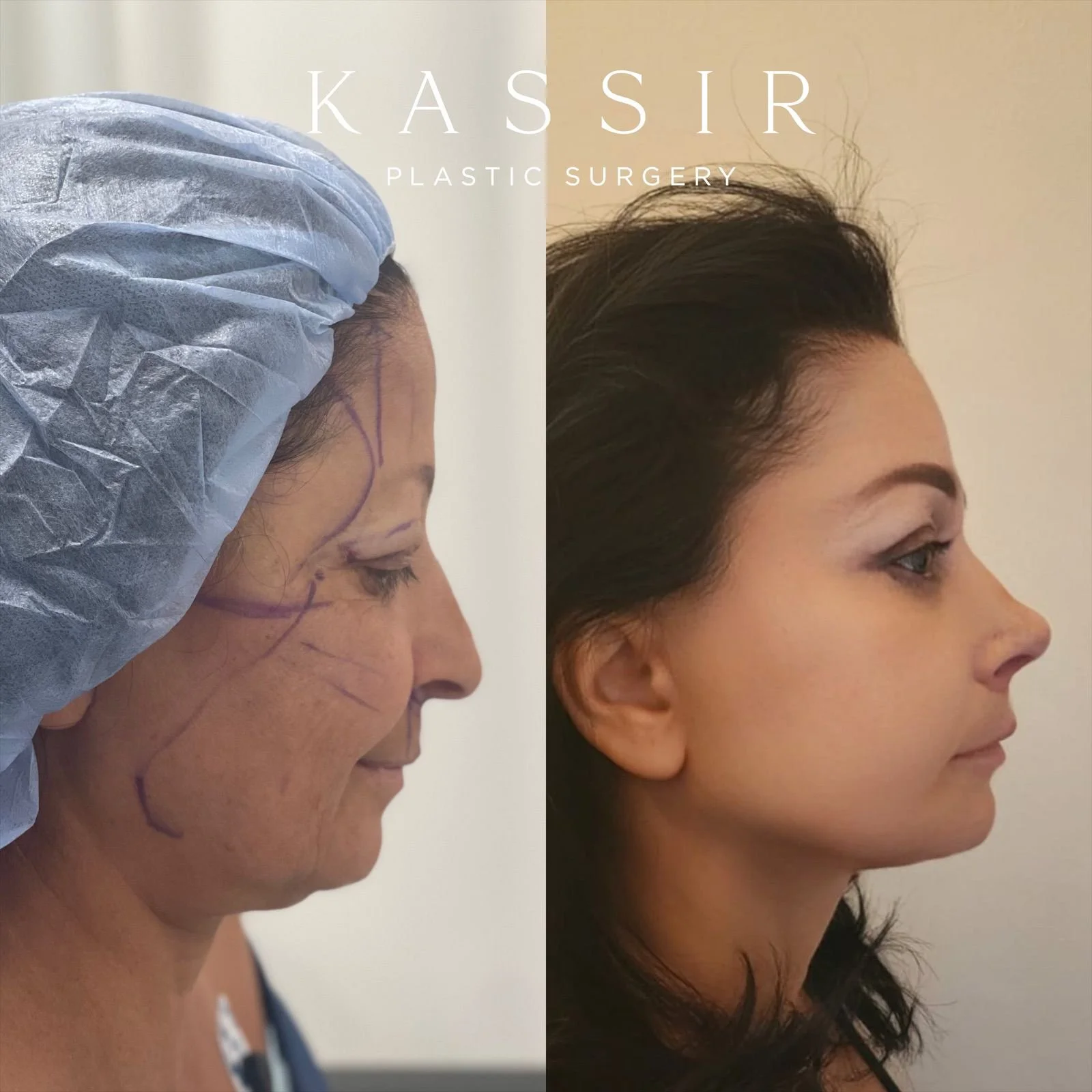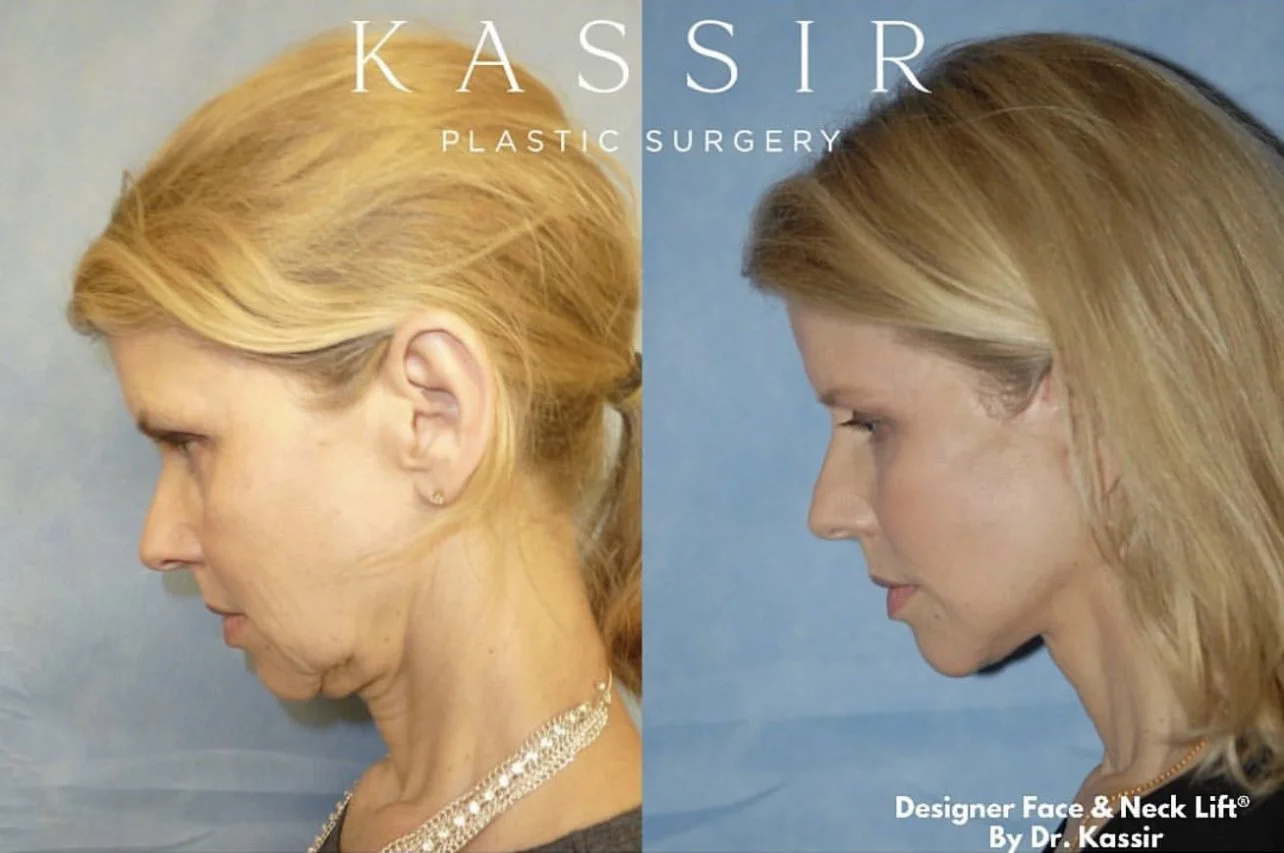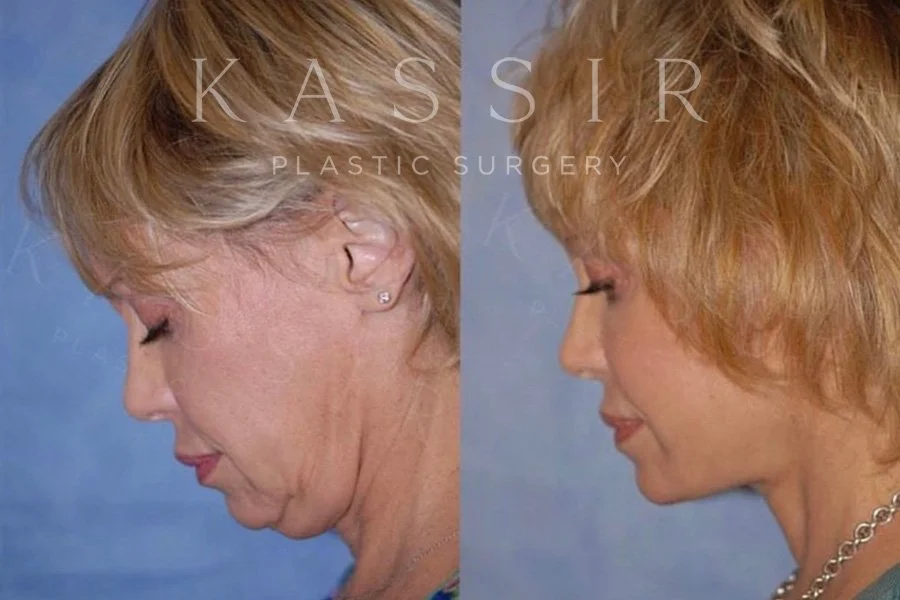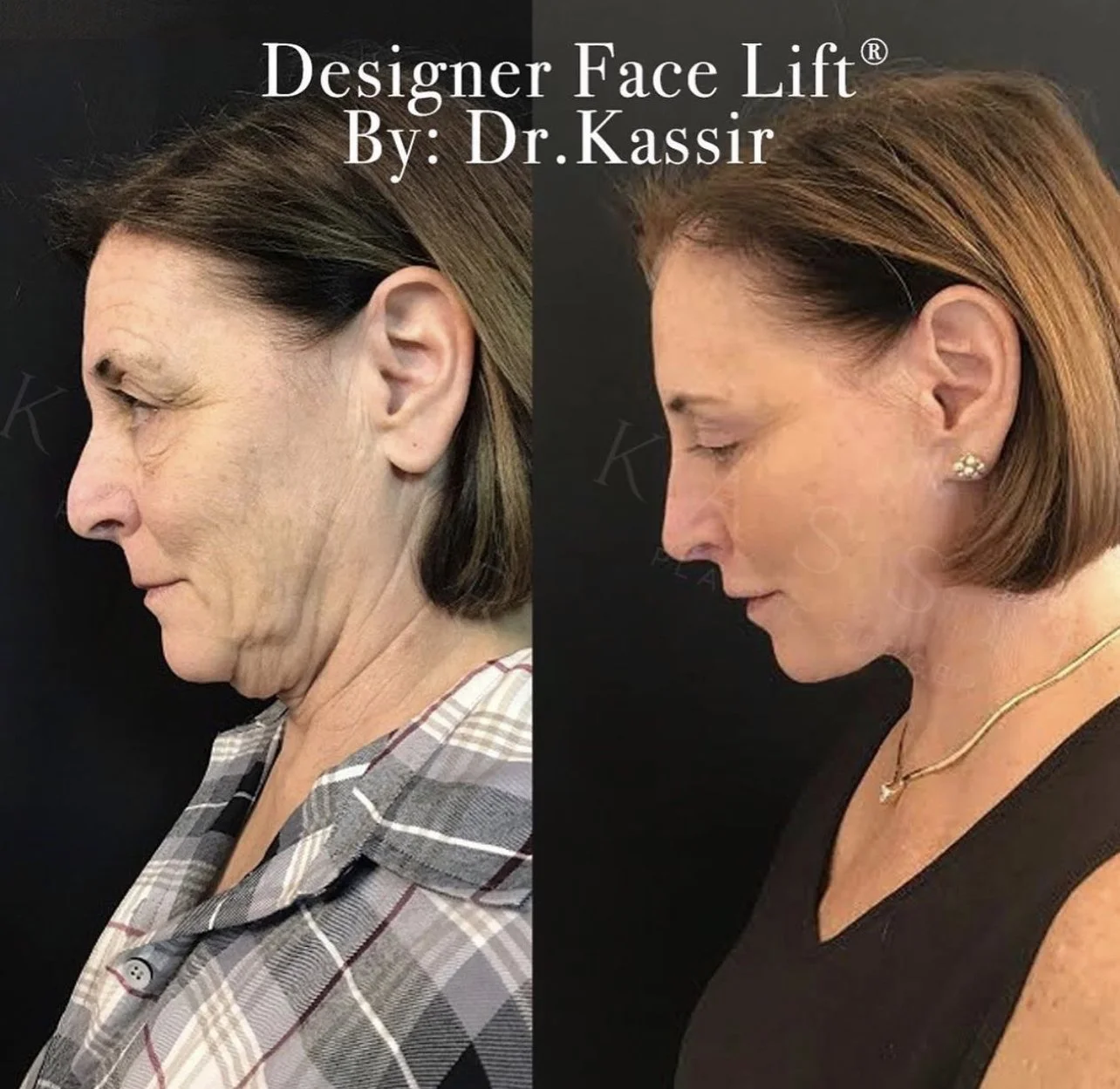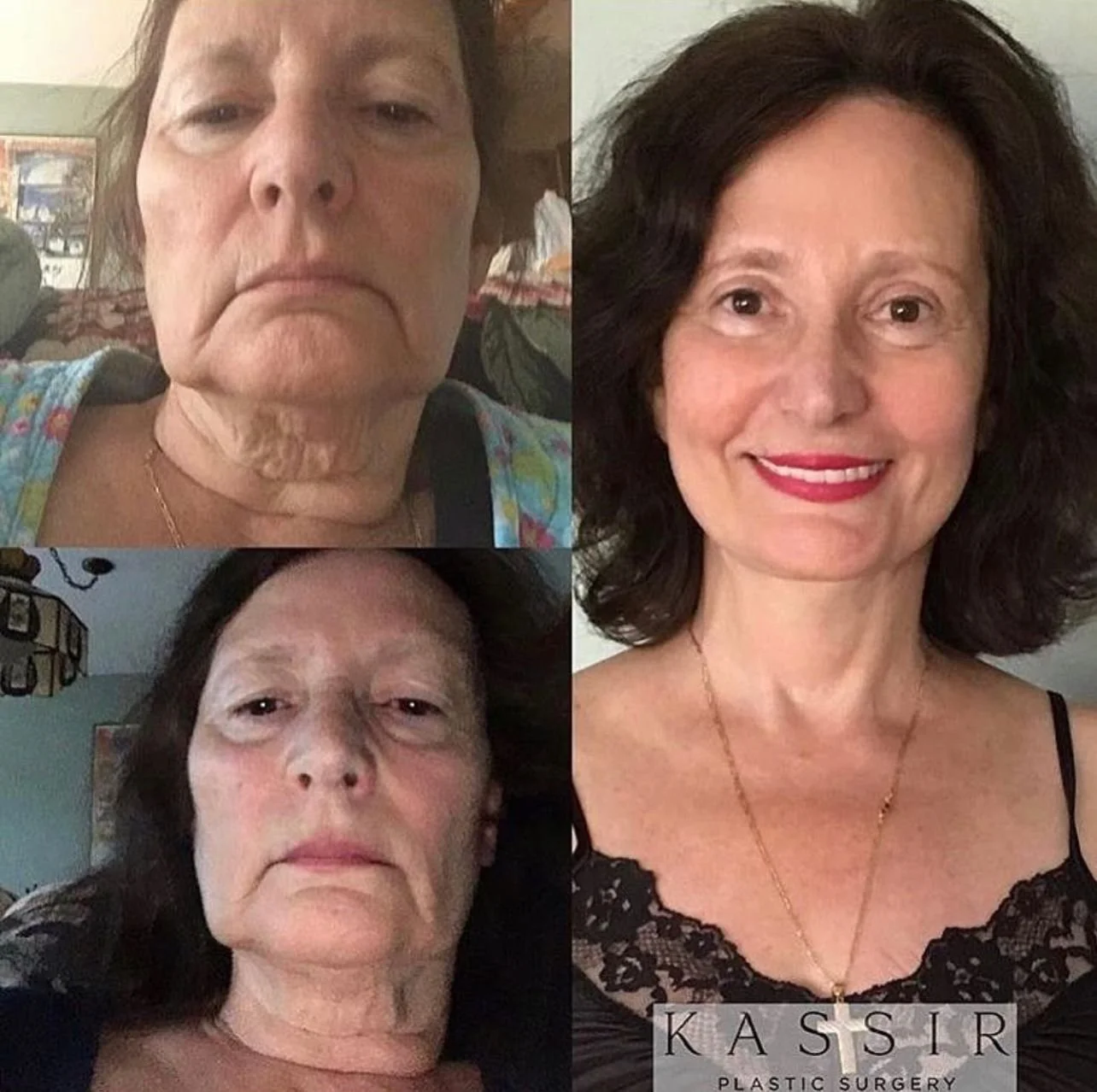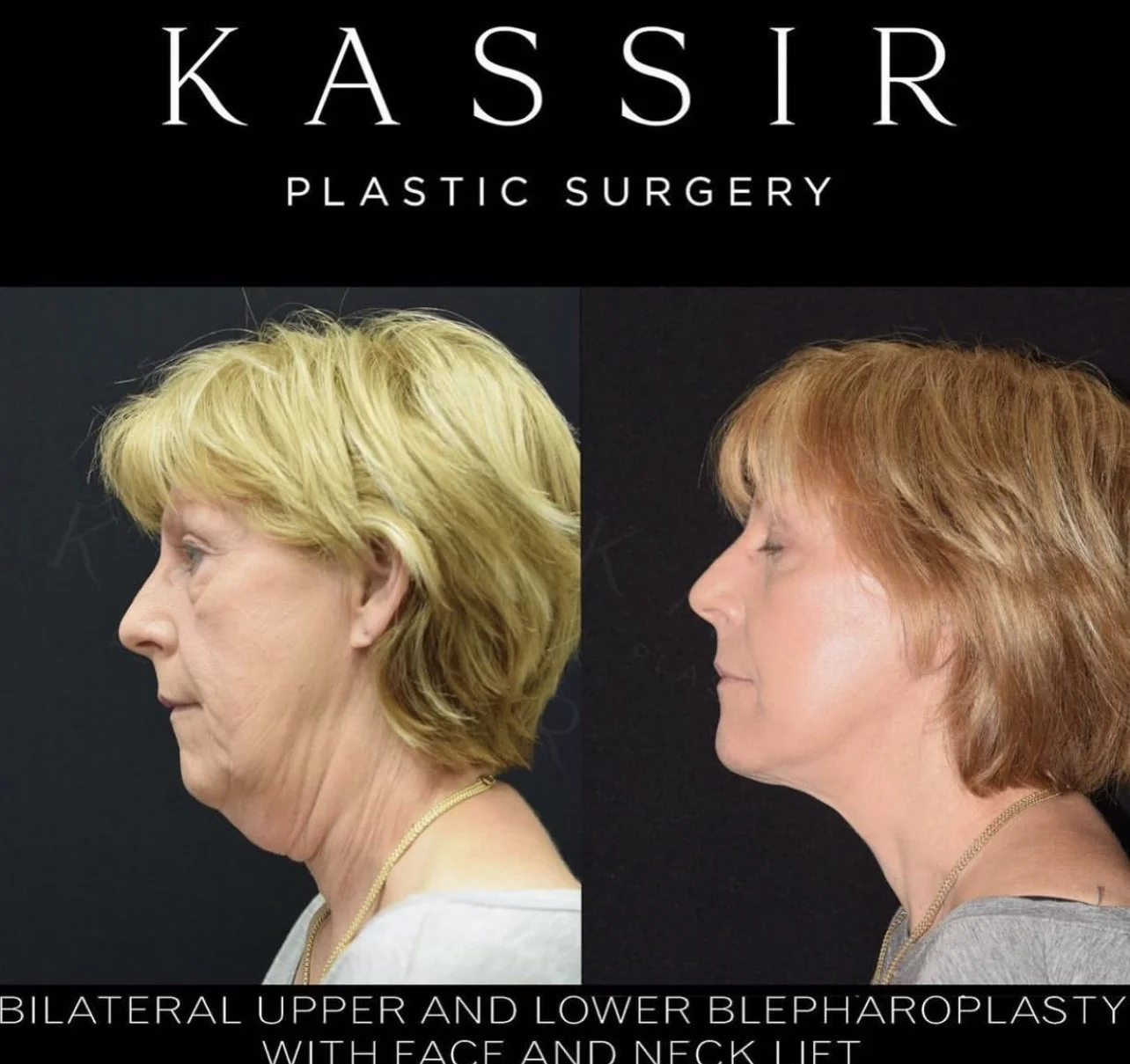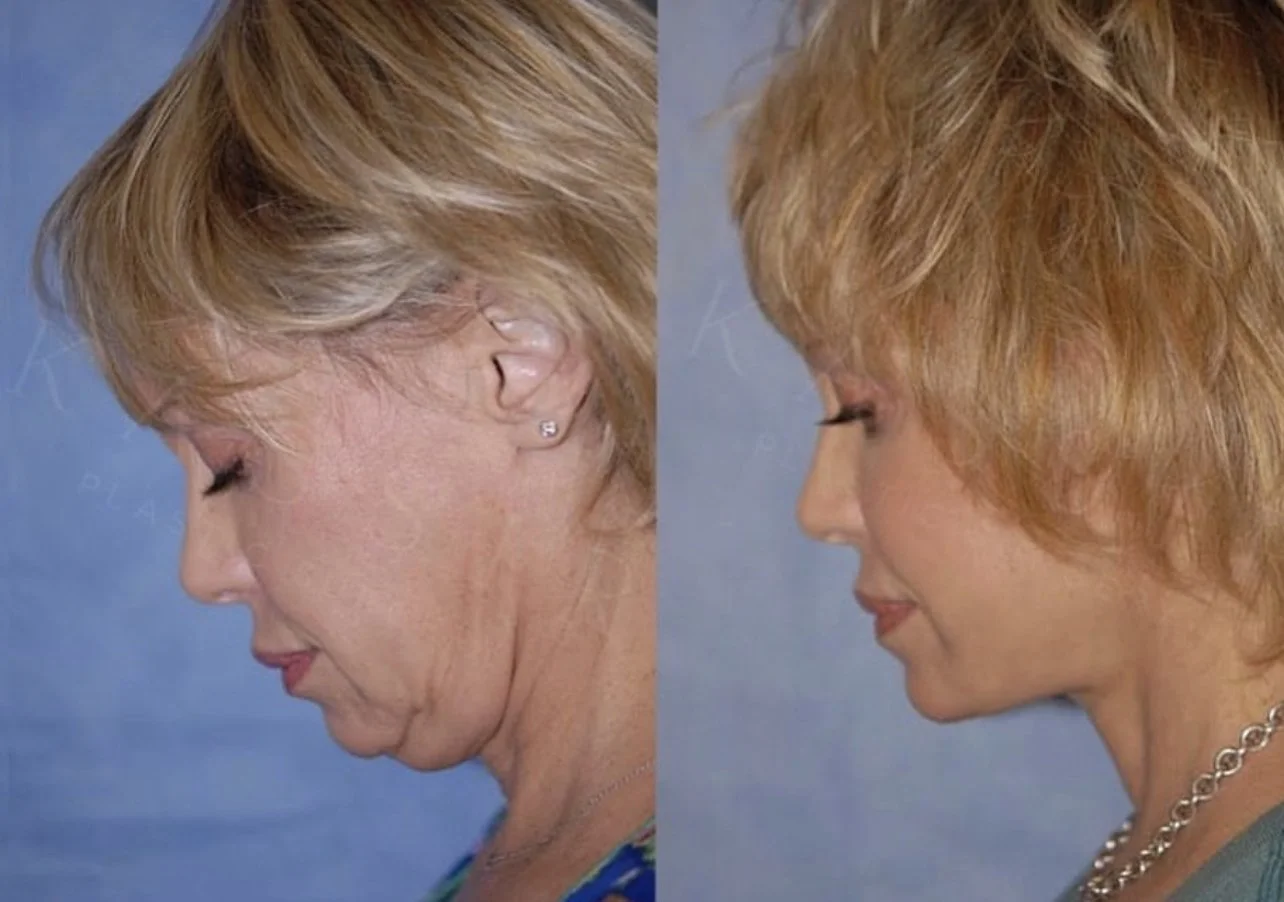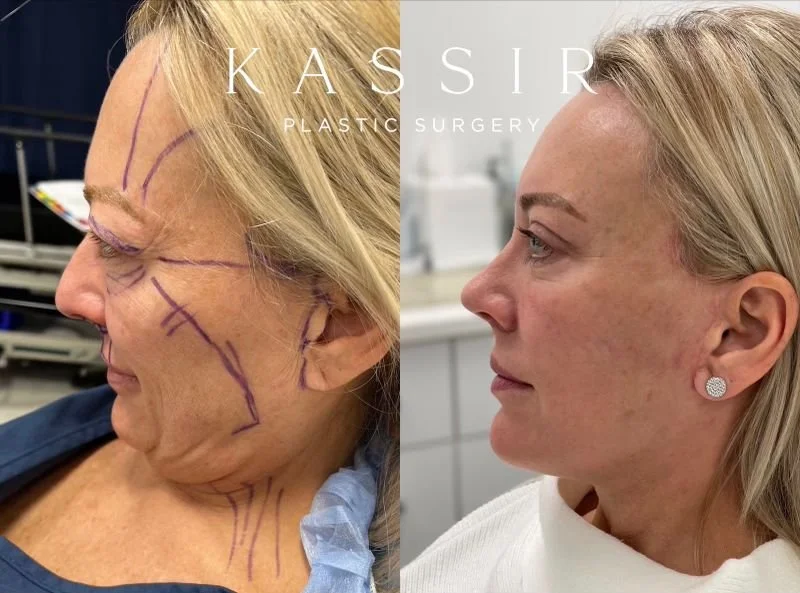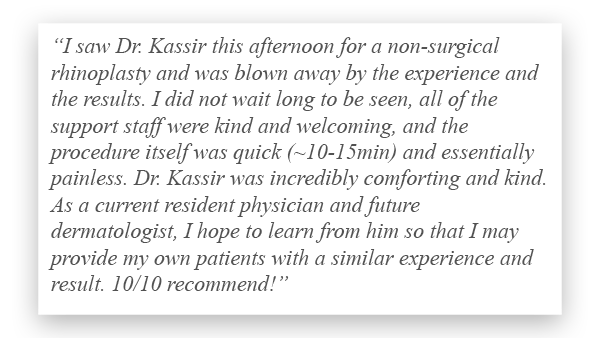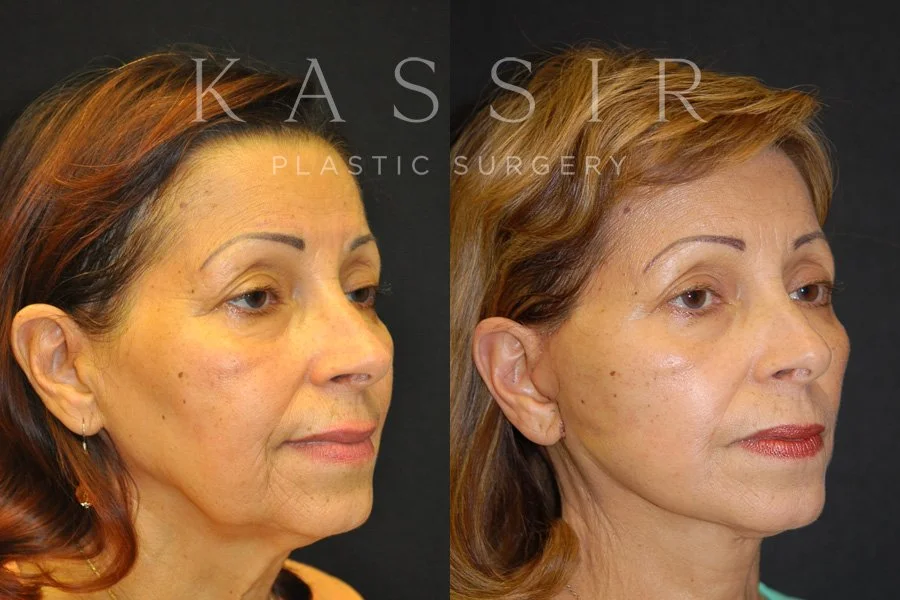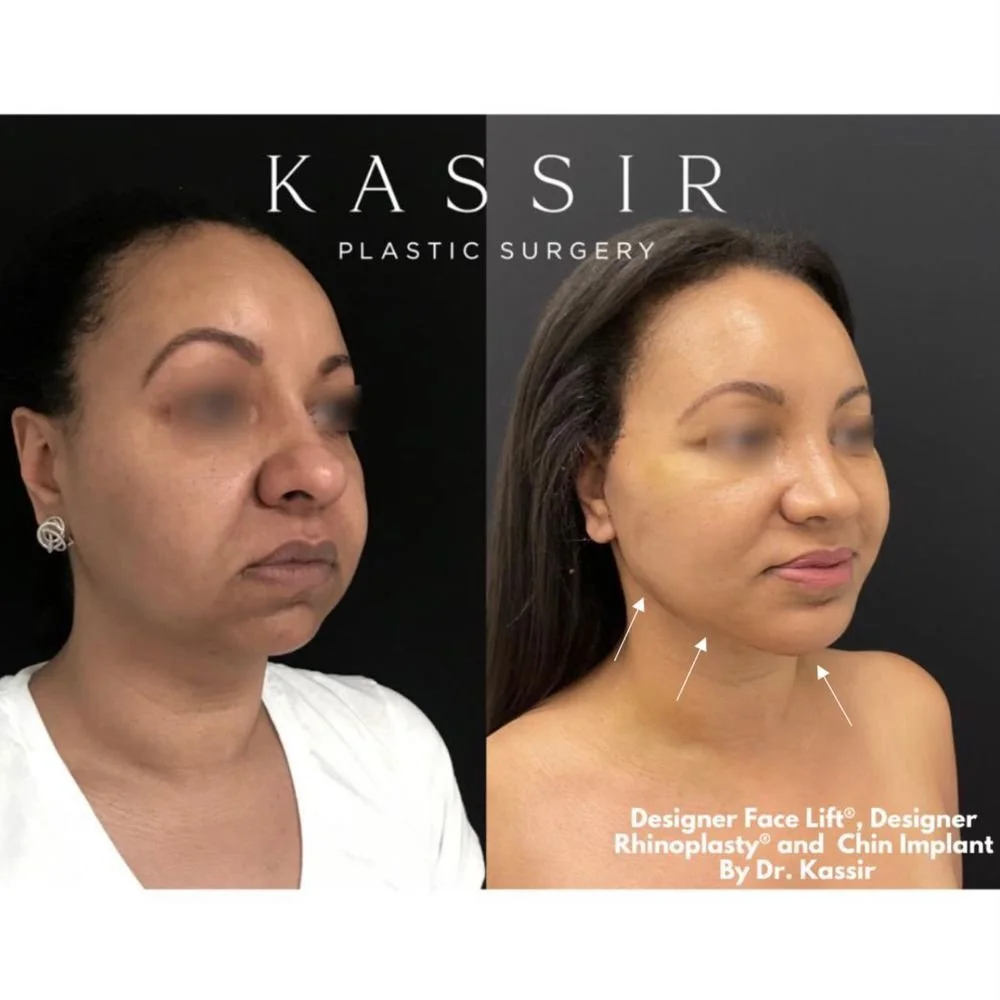
Best Deep Plane Facelift in New York City
Dr. Kassir is the best facelift surgeon in New York City and has been pioneering the Deep Plane Facelift for over 20 years. With over 27 years of experience, he is a triple board-certified Facial Plastic Surgeon who pioneered many techniques. He specializes in deep plane facelifts and strives for natural youthful results.
Facelifts continue to be the third most common plastic surgical procedure (after rhinoplasty and eyelid surgery). In 2020 there were over 230,000 facelifts performed in the US alone. New York City is known for Plastic surgery, and many facelift patients visit the city every year.
Dr. Kassir will sit down with you and discuss your goals for the facelift procedure. He'll go over the different types of facelifts he performs and help you decide which one is right for you. You can rest assured that you're in good hands with Dr. Kassir. He has a wealth of experience and will work hard to give you the best facelift possible.
If you're looking for the best facelift in New York City, look no further than Dr. Kassir. Schedule a consultation today to see what he can do for you. You'll be glad you did!
What is a facelift?
Facelift surgery, also known as rhytidectomy, is a plastic surgery procedure performed to improve the neck laxity, jowls, and midface and produce a more youthful appearance.
As a person ages, the midface begins to sag, producing the smile lines or "laugh lines. The lower face then begins to show jowling, near the chin and the neck muscles sag, producing banding and redundancy. In addition, there might be loose skin around the neck and face. These areas can be improved with the facelift procedure.
A facelift is often combined with a neck lift to improve the jawline and get rid of excess skin around the neck. The facelift does not improve the skin texture or quality but can be combined with procedures such as laser resurfacing that improve texture, age spots, and fine wrinkles.
There are numerous different techniques. The SMAS facelift often focuses only on a minimal lift or plication of the deep structures. A mini facelift will use a suture suspension that has very little downtime but might not be as long-lasting.
Modern facelift techniques involve resuspending the deep connective tissues of the face and allowing the face and neck skin to be elevated and produce a natural rejuvenation. These techniques avoid the "plastic" or stretched appearance so typical of facelift surgeries in the past. The surgery is typically performed with or without general anesthesia, and a 1 to 3-week recovery period is usually necessary after the procedure.
What is a deep plane facelift?
Numerous types of facelift procedures exist. Dr. Kassir is an expert in facial plastic surgery and practices various techniques, but his specialty is the deep plane facelift procedure. The deep plane facelift is different from a traditional facelift technique in that it addresses not only the skin but also the deeper structures of the face, including the muscles and fat. This provides patients with longer-lasting results. There are numerous nuances to the deep plane facelift technique that requires expertise and experience to master. The extended deep plane facelift will extend the deep plane facelift into the neck and achieve full facial rejuvenation. It requires a profound knowledge of anatomy and years of experience to master the deep plane technique. The deep plane facelift can provide patients with a very natural-looking youthful appearance and is by many experts, considered the best facelift technique. During your deep plane facelift consultation with Dr. Dr. Kassir he will explain everything in detail and describe the healing process.
"Nature gives you the face you have at twenty; it is up to you to merit the face you have at fifty."
- Coco Chanel
What happens to our faces as we age?
Our skin is constantly changing; the older we become, the more our skin cells break down and divide slower. The dermis, or lower layer of the skin, also begins to grow thinner. The dermis is comprised of different types of tissue, including elastin and collagen. While the elastin provides elasticity for the skin, the collagen keeps the skin taut. Over time, these proteins begin to break down and lose elasticity in the skin and deeper tissue. The skin begins to sag, as well as the muscle and fat pads. The descent of tissue composition leads to sagging and wrinkles. Although a facelift can lead to a younger-looking face with a better jawline, neck, and midface, it cannot completely erase the signs of age or fix all problems such as sagging eyelids, eyebrows, or skin discoloration. These problems can be fixed with other procedures, for example, an eyelid lift, browlift, or chemical peel. That's why a facelift is very often combined with other procedures to achieve a harmonic and more youthful appearance.
What other surgeries can a facelift include?
In addition to a facelift, Dr. Kassir can perform other types of facial surgery to help you achieve your desired results. These surgeries may include:
Brow lift: This type of surgery can help improve the forehead's appearance by reducing wrinkles and sagging skin.
Eyelid lift surgery: An eyelid lift (blepharoplasty) can help improve appearance and contour by reducing wrinkles, sagging skin, and puffiness around the eyes.
Rhinoplasty (nose job): This type of surgery can improve the nose's appearance by changing its shape or size.
Chin augmentation: This type of surgery can help improve the chin's appearance by making it appear larger or more defined.
Laser skin resurfacing: This type of surgery can help improve the skin's appearance by reducing wrinkles, age spots, and sun damage.
How can a facelift help with facial rejuvenation?
A facelift or deep plane facelift can help improve the appearance of the neck, jawline, and midface. The benefits of facelift surgery include:
improved neck laxity
decrease midface sagging
improve creases under the eyes and between the nose and mouth
reduced jowls
improved midface appearance
tighten loose skin
How much does a deep plane facelift cost?
The cost of a deep plane facelift can vary depending on the extent of the procedure and other factors. During your consultation with Dr. Kassir, he will discuss the cost in detail and provide you with an estimate. Additionally, financing options are available for qualified patients.
At Dr. Kassir's office, we understand that everyone has different financial constraints and we strive to make our services accessible to everyone. The ultimate cost of a facelift will be determined after your consultation and often depends on any additional procedures you might be interested in.
Consult with Dr. Kassir
Dr. Ramtin Kassir has been in practice for over a decade and is an experienced, board-certified plastic surgeon who specializes in facial aesthetics. He has extensive knowledge of the anatomy of the face and neck, which allows him to create natural-looking results with deep plane facelift surgery. Dr. Kassir uses this technique to achieve maximal improvement with minimal incisions, resulting in a youthful and vibrant look. He and his team provide personalized care to ensure the best possible outcome for each patient. With Dr. Kassir, you can be confident that you are receiving the highest quality of care from an experienced and compassionate surgeon who will work with you to achieve your desired results.
If you are interested in learning more about deep plane facelift surgery, contact Dr. Kassir’s office to schedule a consultation today.
What are the risks with facelift procedures and the deep plane facelift?
Like any surgery, there are certain risks associated with deep plane facelift procedure. These include swelling and bruising, hematoma formation (blood collecting underneath the skin), and sometimes numbness and weakness of the facial skin and muscles. These effects tend to be only temporary and will improve over time.
If you're interested in learning more about these types of surgeries, make an appointment with Dr. Kassir today. He will be happy to answer any of your questions and help you decide if this type of facelift is right for you.













Face Lift Gallery
More about facelifts
How is a facelift performed?
The facelift surgery can be performed in Dr. Kassir's office or an accredited surgical center. The patient is usually given a local anesthetic or sedative for the facelift procedure. An incision is made around the temple along the hairline and goes down to the earlobe. An additional incision is made underneath the chin to tighten the skin of the neck. The skin is then separated from the muscle and fat, and the fat may be trimmed or sucked out via liposuction. Dr. Kassir then takes the SMAS (Superficial Musculoaponeurotic System) and releases it from it's deep attachments in a deep plane. He then repositions it at a higher, more youthful level. Tightening and repositioning the SMAS in this manner gives the jawline a sleeker look, and firms the neck. The skin is then pulled back over the area of the incision and the excess skin is removed with a laser or knife. The incision is then closed with stitches, sutures, or tissue glue. The stitches are placed within the hairline so they are hidden. The surgery takes about 2 to 4 hours depending on the extent of muscle and tissue work. The incisions are hidden in the hairline and behind the ear. See our recent blog post for some examples.
There are also other methods to achieve a younger-looking face, that require less time to recover, such as the K-lift™ or liquid facelift with Restylane, Perlane, Belotero, Radiesse, Juvederm, Scultpra, Artefill, or fat.
Many other types of facial lifts are favorable including the mini-lift due to its short recovery time, the S-lift and the K-lift™ which focuses on the lower part of the face (neck and chin), mid-facelift which includes small incisions in the hairline, above the ear, and inside the mouth, and the Tissue-glue facelift which uses tissue glue to seal the incisions made. Some non-surgical techniques are also available with lower costs and fewer risks. Thermage or Thermacool uses radio frequency to activate the body's natural collagen and causes the skin to tighten and contract. This technique is best used for slight wrinkles, and the results can last from six months to two years. Ultherapy uses sound waves to achieve facial and neck tightening. Another alternative is the ThreadLift or FeatherLift, which involves inserting a needle with a surgical thread (or a non-absorbable suture) into the skin. The thread is then pulled tight, and the muscle and tissue tighten with it. This technique leaves no scars, and the thread remains in the body. Some risks of facelifts include infection, scarring, reaction to anesthesia, hematoma, damage to facial nerves, necrosis, and alopecia at the incision site. These risks are minimal, and the procedure results in a younger-looking you
What is the recovery process like after a facelift?
Most people need about two weeks to recover from a facelift. During this time, you will likely have some swelling and bruising. You may also feel tightness in your face and some numbness. These side effects are temporary and will gradually improve as you heal. To help with swelling, you'll be instructed to sleep with your head elevated for the first week or so after surgery. You should also avoid strenuous activity during your recovery period.
The most important thing to remember after a facelift is patience. The body takes time to heal, and your face will look worse before it looks better. Your face may feel tender and tight after the surgery, and there will be discomfort, swelling, and bruising. Dr. Kassir can prescribe painkillers to alleviate the pain and antibiotics to fend off infection. You should be up and about in a few days, and be sure to walk around 3 to 4 times a day to increase circulation and prevent blood clots. The bruising and swelling will subside, and you should be fine in about two weeks. Full recovery, however, may take 1 to 4 months. Do not bend over or lift heavy objects until Dr. Kassir gives the all-clear. Also, stay away from saunas, steam rooms, alcohol, aspirin, and ibuprofen. If Incisions were made in the mouth, consult Dr. Kassir on what to eat until your recovery is completed. Sleep with your head elevated on a pillow and as still as possible. If you experience any extreme pain, excessive redness, or elevated temperature, contact Dr. Kassir immediately.
After your rhytidectomy facelift surgery, Dr. Kassir will wrap the incisions in light bandages. On the next day, your hair can be carefully washed, and the sutures will be removed a week later.
At first, you may experience swelling, numbness, bruising, and a feeling of tightness or tension in the face and neck. Recovery will be noticed usually within 3-6 weeks, and sensation typically returns to normal within a few months. Scars become less red, raised, lumpy, or itchy in time.
Am I a good candidate for a facelift?
If you're considering a facelift, you likely have one or more of the following and are bothered by it:
Signs of an aging face:
1. Wrinkly skin: Over time your skin's natural collagen and elastin begin to break down, which causes wrinkles, lines, folds, and a sagging look. A facelift can help with the sagging skin, but problems such as lines and wrinkles can be better addressed with injectable fillers and good skin care.
2. Sunken eyes: As fat under the eyes starts to descend, your face develops a more sunken look. This looks like a loss of volume around the cheeks and can be fixed most efficiently with a blepharoplasty, small amounts of fat grafts, or injectable fillers as a non-surgical option. Your blepharoplasty can be performed at the same time as your facelift.
3. A saggy jawline: When the jawbone loses density over time, there is less of a structure for the skin to hang on to, therefore the skin begins to sag. To correct this, the loose skin must be excised, and the remaining skin must be tightened by a facelift.
4. Bone changes: With time, the density and volume of the bones in the face begin to decrease. This makes the eyes appear sunken, the jawline becomes less defined, and the cheeks appear flatter. A facelift can help with these changes.
5. Loss of volume: As your face begins to lose fat, the skin begins to droop. The more fat that is lost, the more pronounced folds and lines are. Fat can be taken from different areas and added during your facelift to add more volume. Fillers can also be injected before or after surgery to give your face more volume.
- People who have loose, sagging skin on their face
- People who have deeper wrinkles and folds
- People who want very natural-looking results
What are the different types of Facelifts?
The SMAS (Superficial Musculoaponeurotic System) Facelift is the traditional facelift that pulls up the SMAS layer and is effective for those with jowls and skin laxity. Dr. Kassir's SMAS facelift works to lift and tighten the lower face and neck muscles as well as the skin to produce a more defined jawline and rejuvenated lower face
The Deep Plane Facelift is a modification of the traditional facelift that works more effectively on the midface areas such as nasolabial folds. During surgery, Dr. Kassir lifts the fat pads and muscles of the cheeks to restore volume and youth in the midface region.
The Endoscopic Facelift is a minimally invasive technique using small cameras to guide instruments and allows for lifting the midface and brow. It is most effective for patients seeking to make moderate corrections to a downturned mouth, sagging cheeks, hollowing under eyes, or a drooping forehead. Incisions are only about one inch long and are typically made above the hairline and/or behind the ear, resulting in hidden sutures, a quick recovery time, and almost scarless incision sites.
The Midface Lift is a procedure to specifically target the areas of aging in the midface; the areas between the cheekbones. Dr. Kassir's midface lift is performed endoscopically to reposition the malar fat pads in the cheek area to restore volume in the midface.
The Mini Facelift is related to the traditional facelift but involves smaller incisions behind the ear and focuses on adjusting the skin. The best candidates for a Mini Facelift are patients who are just starting to show signs of aging and seek to tighten their skin, reduce sagging, and reduce nasolabial through a minimally invasive procedure.
The Tissue-glue Facelift is a technique that uses fibrin, a safe biological agent, to close incisions as opposed to sutures.
What are the risks of facelift surgery?
As with any surgery, there are risks associated with facelift surgery. These risks include:
Bleeding
Infection
Swelling and bruising
Facial nerve damage
Skin loss
Scarring
Anesthesia risks
Blood clots
If you want to restore your youthful appearance, let us help you take the first steps.
Set up your deep plane facelift consultation.
We look forward to talking to you.
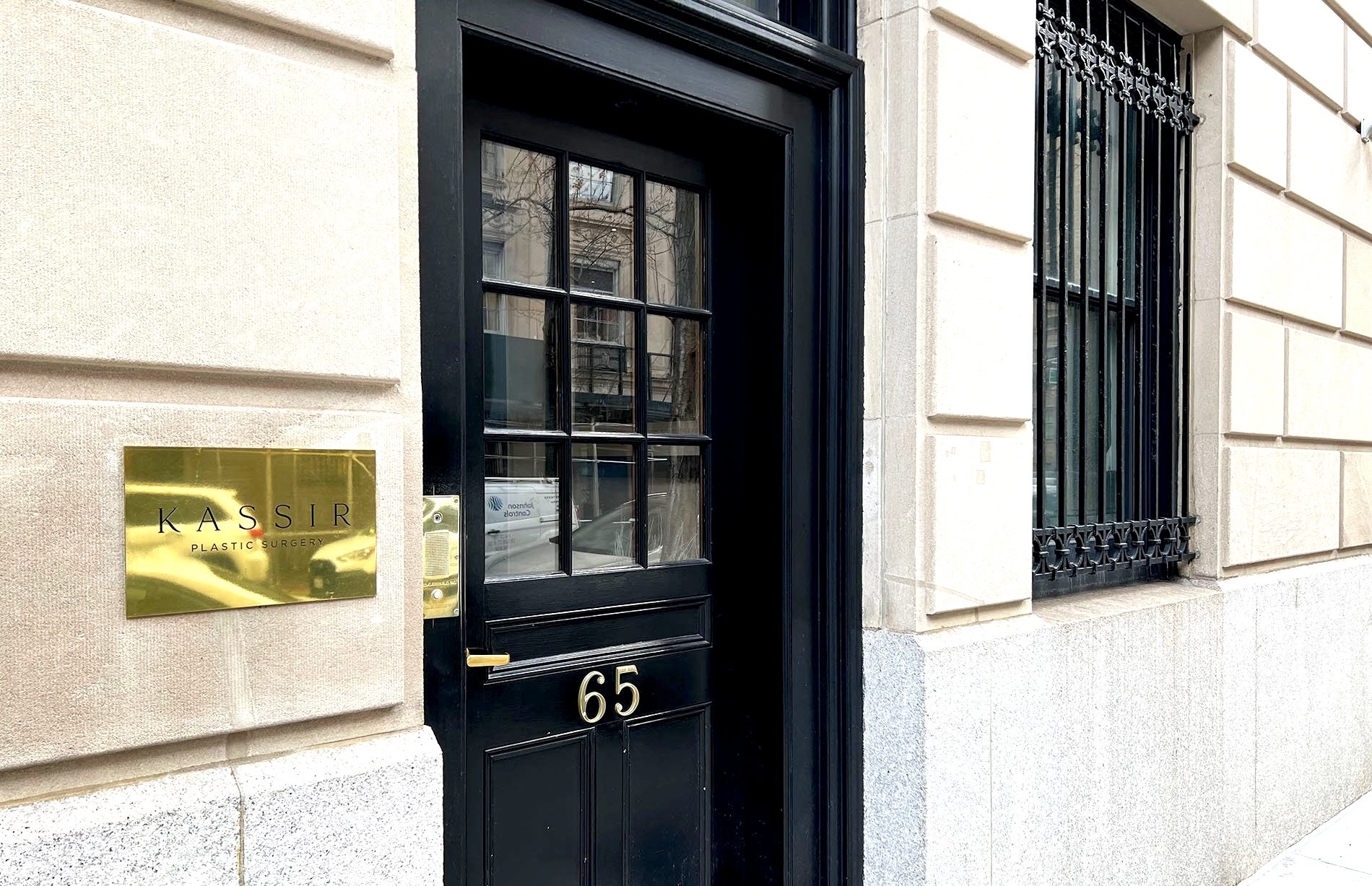

Face Lift Gallery
Frequently asked questions about face lift surgery
-
A facelift can provide many benefits, including:
smoother, firmer skin
reduced wrinkles and fine lines
improved skin tone and texture
restored facial volume
rejuvenated appearance
-
Most facelift results last around 10 years. However, your facelift's longevity depends on several factors, including your age, lifestyle, and genetics. In addition, deep plane facelifts are able to provide a stronger suspension and are often quoted to be longer lasting than traditional techniques. To maintain the results of your facelift, you'll need to follow Dr. Kassir's post-operative instructions closely.
-
There is no definitive answer to this question as facelift surgery is unique to each individual. The best age for facelift will depend on factors such as skin laxity, bone structure, and the overall condition of your skin. However, most patients who undergo facelift surgery are between 40 and 60 years old
-
Most facelift patients report only mild discomfort after surgery. During surgery, you will either be full asleep with general anesthesia, or Dr. Kassir will administer local anesthesia and a sedative to help keep you comfortable. After your facelift, you may experience some bruising and swelling. These side effects are temporary and can be managed with over-the-counter pain medication. The majority of discomfort is resolved after the first week of surgery. ion
-
Yes, you can have multiple facelifts. Depending on when you have you have your first facelift, it is not uncommon to have a second facelift down to the line to tighten the tissues once more. Some patients need small corrections after their facelift as well.
-
The facelift scars are hidden in the hairline and behind the ear. They are very well camouflaged and almost imperceptible.
-
If you're not ready for facelift surgery, there are several non-surgical options that can help you achieve a youthful appearance. These include injectables such as Botox and fillers, laser skin resurfacing, and Ultherapy.



